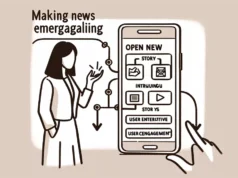In a rapidly changing digital landscape, consuming news and content has evolved notably over the past decade. Broad changes in audience behavior have largely been driven by advancements in technology, particularly the rise of smartphone usage and the ever-increasing pervasiveness of social media. Today, audiences are demanding personalized, authoritative, and real-time content – effectively on their terms.
In the past, publishers had the control over what, how, and when the content got served to audiences. But now, with the expansion of digital platforms, audiences have more control. They get to choose when, where, and how they engage with content. As per the Digital News Report 2020 by the Reuters Institute and Oxford University, 41% of respondents preferred using smartphones to access news, while only 30% opted for computers and the other managed with tablets and smart speakers.
One of the most prominent shifts today is the increased demand for personalized content. GlobalWebIndex reports that 29% of internet users say they’re interested in receiving more personalized news. This number goes up to 36% and 31% for Gen Z and Millennials, respectively. As consumers gain unlimited access to an overwhelming amount of information, personalization has become paramount – it’s no longer a bonus, but expected.
Another demand that audiences have begun to express strongly is for content to be more trustworthy. According to the Edelman Trust Barometer 2020, which surveyed people in 28 countries, 57% of respondents believe that media outlets are contaminating the political conversation. At the same time, 76% are worried about fake news and false information being used as a weapon. Now, more than ever, audiences look for accurate, trusted content.
Furthermore, audiences also want content that is easy to consume. This encompasses not just the simplicity of language, but also the medium of delivery. A study by Mobile Ecosystem Forum found that 41% of people use instant messaging apps for sharing news articles, with Facebook Messenger and WhatsApp being the most popular platforms. This shift towards sharing content through private messaging reflects how audiences prefer digestible and easily shareable content.
In response to this wave of change, publishers and content creators are recalibrating their strategies. Techniques like machine learning and AI are being used to generate tailor-made content suggestions. Large tech companies like Google have also rolled out initiatives like Google News Initiative to ensure that people receive authoritative and trustworthy information.
On the other hand, several news organizations have moved towards monetized subscription models, providing readers with an ad-free premium experience. The New York Times, for instance, gained 587,000 new digital subscribers in Q1 2020, a company record, led by its coronavirus coverage. However, this raises questions about the accessibility of news, especially during times when obtaining reliable information is critical.
While being met with challenges, these changes put forth by audiences present an unparalleled opportunity for innovation. As media landscapes continue to shift, content creators, journalists, and news organizations have the unique prospect of reshaping not just how content is delivered, but perhaps even what the very nature of ‘news’ is.
Sources:
1. Newman, Nic et al. “Digital News Report 2020.” Reuters Institute, University of Oxford.
2. “Media Consumption Trends: The surge in screen time.” GlobalWebIndex, 2020.
3. Edelman Trust Barometer 2020.
4. Mobile Messaging App Map 2020. Mobile Ecosystem Forum.
5. Tracy, Marc. “The New York Times Co. Reports Record New Subscriptions.” New York Times, May 6, 2020.






